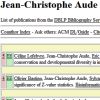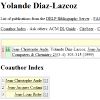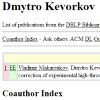Publications related to 'pyramid' : A pyramid over a set X is a set P of clusters of X which contains X, the singletons formed by its elements, and has the following properties:
- the intersection of two elements of P is either empty or in P
- there exists an order on X such that each element of P is an interval in this order.
A pyramid can be represented by a planar rooted pyramidal representation.
|
Order by: Type | Year
|
|
|
|
|
|
|
|
|
|
| |
   
Jean-Christophe Aude,
Yolande Diaz-Lazcoz,
Jean-Jacques Codani and
Jean-Loup Risler. Applications of the Pyramidal Clustering Method to Biological Objects. In CC, Vol. 23(3-4):303-315, 1999.
Keywords: from distances, phylogenetic network, phylogeny, Program Pyramids, pyramid, reconstruction, software, visualization.
Note: http://dx.doi.org/10.1016/S0097-8485(99)00006-6.
|
|
| |
|
| |

François-Joseph Lapointe. How to account for reticulation events in phylogenetic analysis: A review of distance-based methods. In Journal of Classification, Vol. 17:175-184, 2000.
Keywords: abstract network, evaluation, from distances, phylogenetic network, Program Pyramids, Program SplitsTree, Program T REX, pyramid, reconstruction, reticulogram, split network, survey, weak hierarchy.
Note: http://dx.doi.org/10.1007/s003570000016.
|
|
| |
 
David Posada and
Keith A. Crandall. Intraspecific gene genealogies: trees grafting into networks. In TEE, Vol. 16(1):37-45, 2001.
Keywords: likelihood, median network, netting, parsimony, phylogenetic network, phylogeny, Program Arlequin, Program SplitsTree, Program T REX, Program TCS, pyramid, reticulogram, split decomposition, statistical parsimony, survey.
Note: http://darwin.uvigo.es/download/papers/09.networks01.pdf.
|
|
|
|
|
|
| |
  
Vladimir Makarenkov,
Dmytro Kevorkov and
Pierre Legendre. Phylogenetic Network Construction Approaches. In Applied Mycology and Biotechnology, Vol. 6:61-97, 2006.
Keywords: from distances, hybridization, lateral gene transfer, median network, NeighborNet, netting, Program Arlequin, Program Network, Program Pyramids, Program Reticlad, Program SplitsTree, Program T REX, Program TCS, Program WeakHierarchies, pyramid, reticulogram, split, split decomposition, split network, survey, weak hierarchy.
Note: http://www.labunix.uqam.ca/~makarenv/makarenv/MKL_article.pdf.
|
|
|
|
|
|
| |
|
| |

Philippe Gambette. Méthodes combinatoires de reconstruction de réseaux phylogénétiques. PhD thesis, Université Montpellier 2, France, 2010.
Keywords: abstract network, characterization, circular split system, explicit network, FPT, from clusters, from triplets, integer linear programming, level k phylogenetic network, NP complete, phylogenetic network, phylogeny, Program Dendroscope, pyramid, reconstruction, split network, weak hierarchy.
Note: http://tel.archives-ouvertes.fr/tel-00608342/en/.
|
|
|
|
|
|
|
|
 - forked on GitHub.
- forked on GitHub.












